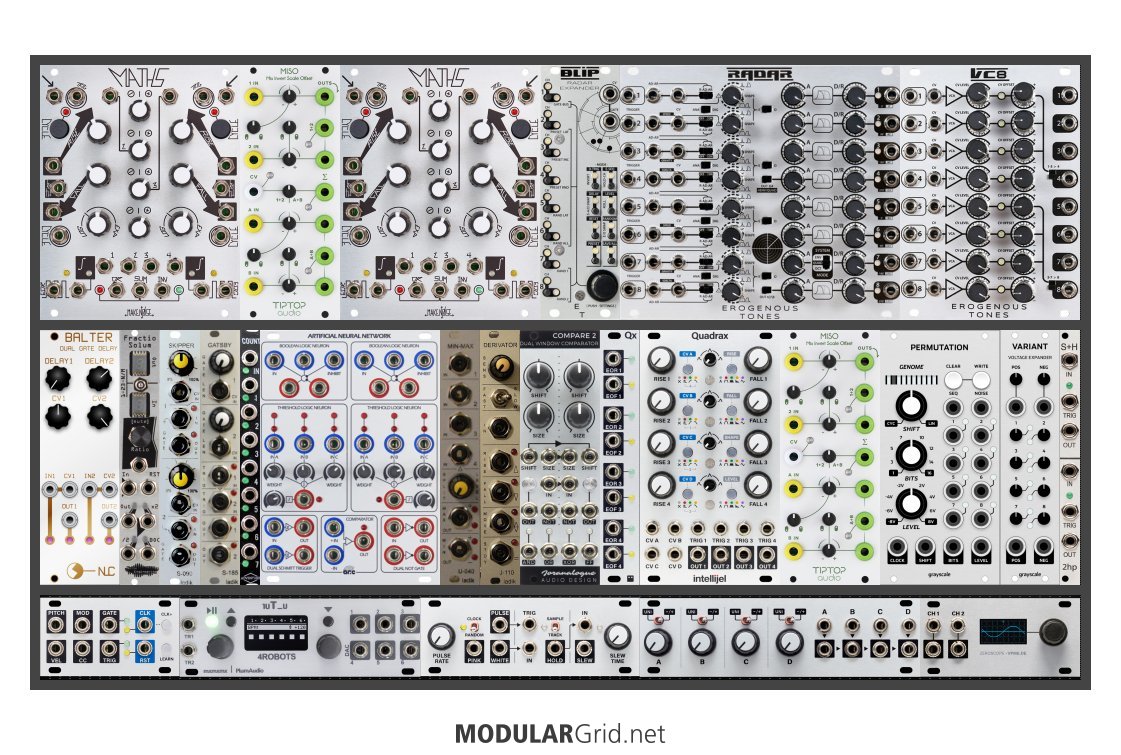Ooookay...I whipped up a "control build" to give something of an example of how a device like this could be configured. You'll notice the absence of sound generation/modification modules...this is PURELY a build for outputting various modulation, clocking, etc signals back to Ableton's VST environment with CV Tools. Also note that the interfacing is NOT part of the build; I was disappointed at the lack of inputs that the Expert Sleepers interfaces offer, so I opted instead to make this something that can work with an outboard A/D. This way, via expansions to that architecture, you can build up whatever you like as far as I/O, and all you'll need is a patchbay to get at the A/D conversion, with all of this being expandable as needs be. However, DO check this list before looking at A/D conversion, because CV Tools requires you to use a DC-coupled interface: https://www.expert-sleepers.co.uk/siwacompatibility.html

I still used the Intellijel 7U here, as the tile row offers some useful utility aspects that fit in the context of this build. However, you'll note that I've inverted the cab, bringing the tile row to the front. Also, even though this might seem comprehensive, it's still lacking in a few things; for example, I'd have wanted to also put a matrix mixer in here, but the other devices crowded that out.
The top row gives a pair of Maths with a MISO for crossmodding/mixing each other, plus giving complex composite outputs from them. Then the right half there is a suite of Erogenous Tones devices...the BLIP is a sequential/memory/probably a few other things controller for their massive AR envelope gen bank, the RADAR. Then there are eight mixable VCAs after this, with their VC8.
Bottom row is a little more complicated. Everything from the left to the middle involves logic pulses and timing modifiers: dual pulse delay, CVable pulse divider/multiplier, a dual probabilistic skipper, Ladik's "Gatsby" which is a trig-to-gate generator, a pulse counter (1 to 7, "0" is the original pulse), and the main logic "guts" are ARC's Artificial Neural Network, which is Boolean taken to a "next level". After that are three "CV readers"...a Min/Max for manipulating CV levels, a Derivator for tracking CV movement, then a dual window comparator for picking gates off of modulation signals via CV thresholds. The Qx/Quadrax gives you a rather different take on the RADAR, as these are easily patchable envelope gens that can be cascaded, made to cross-signal other modules, and so on. Then another MISO (useful!) just before a Permutation + Variant random sequencer and a dual sample and hold to deal with random activity.
Tile row has a MIDI interface (the only thing using the 7U cab's external connectors, btw), then a Temps Utile for clocking and messing with clock behavior, a Noise Tools for another S&H, a master (maybe) clock, slew limiter and the like. After that, a QuadrATT provides manual attenuversion and mixing, then Intellijel's version of the Zeroscope because, with a rig like this, you WILL want some visual feedback to see what your patching is causing.
Again, this isn't a "proper synth", but a complex controller designed to make changes and actions that Ableton doesn't like to do nicely...or rather, that computers in general don't like to do nicely. By using CV Tools to link this control signal generating build to your VSTs and other Ableton architecture, you can make that stuff do things that, as mentioned, would likely cause the computer to have fits because smooth, linear curves are something that computers DON'T do well. Sure, they can MAKE them...but when you call on a computer to generate some really complicated behavior of this type while it's ALSO running Ableton itself, you're asking for trouble. This takes that away from the computer (to a sizable extent), which frees it up...and lets Ableton do a few things it's not exactly supposed to.

